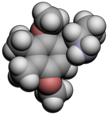Ganesha (psychedelic)
In this article, we are going to address the topic of Ganesha (psychedelic) from a broad and detailed perspective. Ganesha (psychedelic) is a topic of great relevance in today's society, since it impacts various aspects of daily life. Along these lines, we are going to explore the different facets of Ganesha (psychedelic), analyzing its causes, consequences and possible solutions. Furthermore, we will examine the role that different actors play in relation to Ganesha (psychedelic), as well as the ethical and moral implications it entails. Ultimately, this article aims to offer a comprehensive view of Ganesha (psychedelic), with the aim of providing the reader with a deeper and enriching understanding of this very relevant topic.
| |||
| Names | |||
|---|---|---|---|
| Preferred IUPAC name
1-(2,5-Dimethoxy-3,4-dimethylphenyl)propan-2-amine | |||
| Other names
3,4-Dimethyl-2,5-dimethoxyamphetamine;
2-(3,4-Dimethyl-2,5-dimethoxyphenyl)-1-methyl-1-aminoethane | |||
| Identifiers | |||
3D model (JSmol)
|
|||
| ChEMBL | |||
| ChemSpider | |||
PubChem CID
|
|||
| UNII | |||
CompTox Dashboard (EPA)
|
|||
| |||
| |||
| Properties | |||
| C13H21NO2 | |||
| Molar mass | 223.316 g·mol−1 | ||
Except where otherwise noted, data are given for materials in their standard state (at 25 °C , 100 kPa).
| |||
Ganesha (2,5-dimethoxy-3,4-dimethylamphetamine) is a lesser-known psychedelic drug. It is also a substituted amphetamine. It was first synthesized by Alexander Shulgin.[citation needed] In his book PiHKAL, the dosage range is listed as 24–32 mg. The drug is usually taken orally, although other routes such as rectally may also be used.[citation needed] Ganesha is synthesized from 2,5-dimethoxy-3,4-dimethylbenzaldehyde. Ganesha is the amphetamine analog of 2C-G. It is a particularly long lasting drug, with the duration listed in PiHKAL as being 18–24 hours, which might make it undesirable to some users. It is named after the Hindu deity, Ganesha. Very little is known about the dangers or toxicity of ganesha. Effects of ganesha include:
- Strong closed-eye visuals
- An increased appreciation of music
- Powerful relaxation and tranquility
Homologues
G-3

2,5-Dimethoxy-3,4-(trimethylene)amphetamine:
- Dosage: 12–18 mg
- Duration: 8-12 h
- Effects: Enhancement of reading, no visuals or body load.
- 2C analog: 2C-G-3
G-4

2,5-Dimethoxy-3,4-(tetramethylene)amphetamine:
G-5
3,6-Dimethoxy-4-(2-aminopropyl)benzonorbornane:
G-N

1,4-Dimethoxynaphthyl-2-isopropylamine:
Legality
United Kingdom
This substance is a Class A drug in the Drugs controlled by the UK Misuse of Drugs Act.
See also
References
- ^ a b Ganesha Entry in PiHKAL
- ^ G-3 entry in PiHKAL
- ^ G-4 entry in PiHKAL
- ^ G-5 entry in PiHKAL
- ^ G-N entry in PiHKAL
- ^ "UK Misuse of Drugs act 2001 Amendment summary". Isomer Design. Archived from the original on 22 October 2017. Retrieved 12 March 2014.

